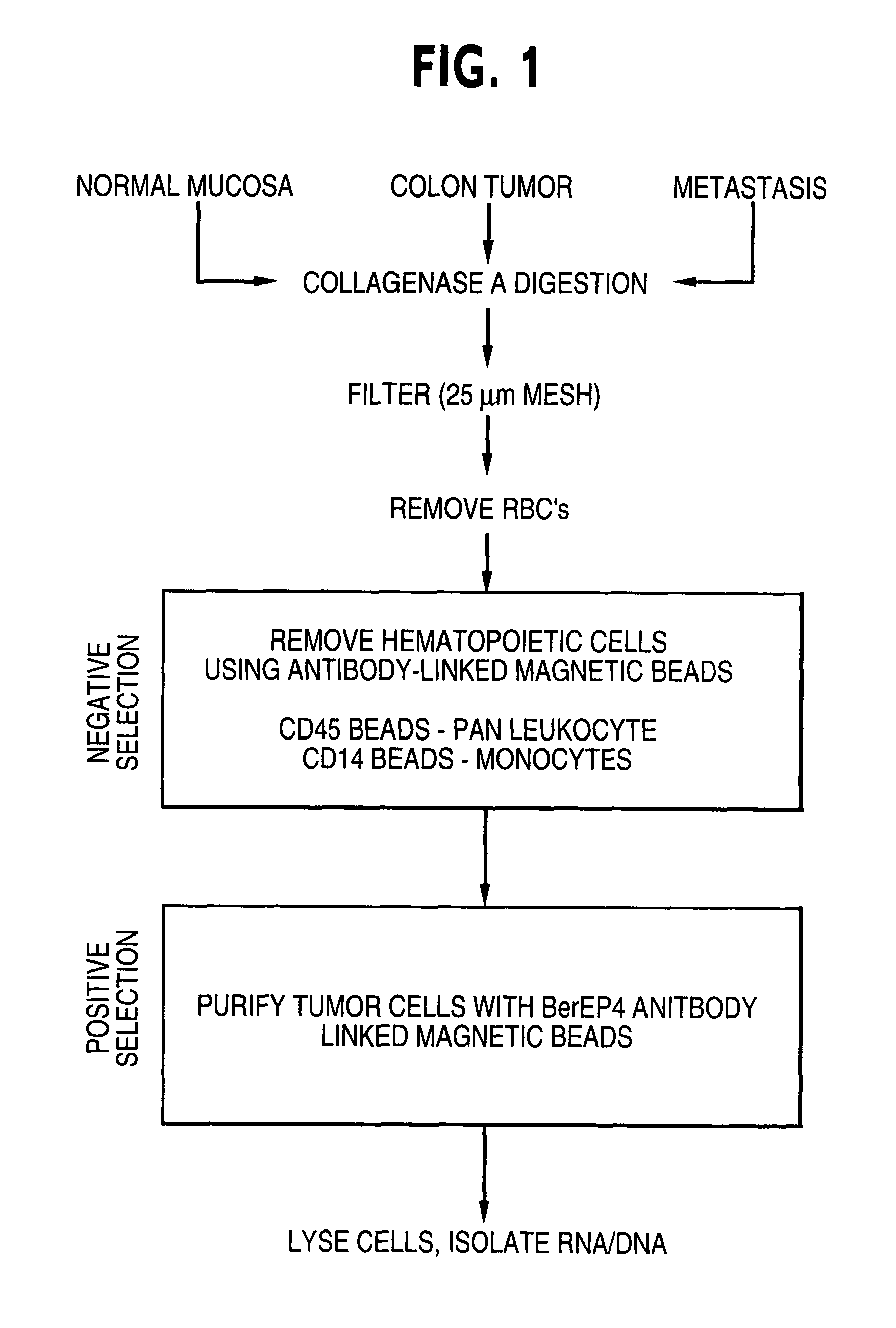Phosphatase associated with metastasis
a phosphatase and metastasis technology, applied in the field of cancer diagnostics and therapeutics, can solve the problems that no gene has been consistently and specifically activated in liver metastases, and achieves the effect of improving the sensitivity and safety of patients
- Summary
- Abstract
- Description
- Claims
- Application Information
AI Technical Summary
Benefits of technology
Problems solved by technology
Method used
Image
Examples
example 1
SAGE Analysis of Liver Metastases
[0034]To learn which genes might be involved in this process, we performed global gene expression profiles of liver metastases using Serial Analysis of Gene Expression (SAGE) technology (5). We first prepared a SAGE library from microdissected metastases (6). Surprisingly, we found that many of the transcripts identified in these libraries were characteristic of normal hepatic or inflammatory cells, precluding quantitative analysis (7). To produce a more specific profile of metastatic epithelial cells, we developed an immunoaffinity fractionation procedure to purify colorectal epithelial cells from contaminating stromal and hepatic cells (8). A SAGE library was prepared from cells purified in this manner, yielding ˜95,000 tags representing at least 17,324 transcripts (6). These tags were compared to ˜4 million tags derived from diverse SAGE libraries, particularly those from normal and malignant (but non-metastatic) colorectal epithelium (9). One hun...
example 2
Real-time PCR on Multiple Metastatic Lesions
[0042]Transcripts that were enriched rather than depleted in the metastasis library have obvious diagnostic and therapeutic potential. We therefore selected 38 of the most interesting enriched transcripts for further analysis (Table 1) (11). To confirm the SAGE data, we compared the expression of these transcripts in several microdissected metastases, primary cancers, pre-malignant adenomas, and normal epithelium by quantitative, real-time PCR (8). Though all 38 of these transcripts were found to be elevated in at least a subset of the metastatic lesions tested, only one gene, PRL-3, was found to be consistently overexpressed.
[0043]In Table 1, SAGE TAG refers to the 10 bp sequence immediately adjacent to the NlaIII restriction site (CATG) in each transcript. SAGE libraries were constructed from two normal colonic tissues (one library containing 48,479 tags, the other 49,610 tags), two primary colorectal cancers (one library containing 55,7...
example 3
Correlation of Expression of PRL-3 with Metastasis
[0044]PRL-3 (also known as PTP4A3) encodes a small 22 kD tyrosine phosphatase that is located at the cytoplasmic membrane when prenylated at its carboxyl terminus and in the nucleus when it is not conjugated to this lipid (12). Among normal human adult tissues, it is expressed predominantly in muscle and heart (13). Although PRL-3 had not been linked previously to human cancer, overexpression of PRL-3 has been found to enhance growth of human embryonic kidney fibroblasts (13) and overexpression of PRL-1 or PRL-2, close relatives of PRL-3, has been found to transform mouse fibroblasts and hamster pancreatic epithelial cells in culture and promote tumor growth in nude mice (14, 15). Based on this information, our preliminary expression data, and the importance of other phosphatases in cell signaling and neoplasia, we examined PRL-3 in greater detail. We first investigated PRL-3 expression in epithelial cells purified from colorectal ti...
PUM
| Property | Measurement | Unit |
|---|---|---|
| adhesion | aaaaa | aaaaa |
| time | aaaaa | aaaaa |
| fluorescent | aaaaa | aaaaa |
Abstract
Description
Claims
Application Information
 Login to View More
Login to View More - R&D
- Intellectual Property
- Life Sciences
- Materials
- Tech Scout
- Unparalleled Data Quality
- Higher Quality Content
- 60% Fewer Hallucinations
Browse by: Latest US Patents, China's latest patents, Technical Efficacy Thesaurus, Application Domain, Technology Topic, Popular Technical Reports.
© 2025 PatSnap. All rights reserved.Legal|Privacy policy|Modern Slavery Act Transparency Statement|Sitemap|About US| Contact US: help@patsnap.com



